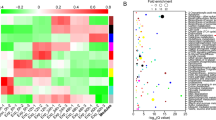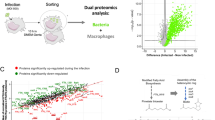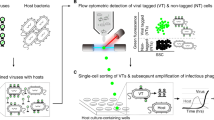Abstract
Tapping into the metabolic crosstalk between a host and its virus can reveal unique strategies employed during infection. Viral infection is a dynamic process that generates an evolving metabolic landscape. Gaining a continuous view into the infection process is highly challenging and is limited by current metabolomics approaches, which typically measure the average of the entire population at various stages of infection. Here, we took an innovative approach to study the metabolic basis of host–virus interactions between the bloom-forming alga Emiliania huxleyi and its specific virus. We combined a classical method in virology, the plaque assay, with advanced mass spectrometry imaging (MSI), an approach we termed ‘in plaque-MSI’. Taking advantage of the spatial characteristics of the plaque, we mapped the metabolic landscape induced during infection in a high spatiotemporal resolution, unfolding the infection process in a continuous manner. Further unsupervised spatially aware clustering, combined with known lipid biomarkers, revealed a systematic metabolic shift during infection towards lipids containing the odd-chain fatty acid pentadecanoic acid (C15:0). Applying ‘in plaque-MSI’ may facilitate the discovery of bioactive compounds that mediate the chemical arms race of host–virus interactions in diverse model systems.
This is a preview of subscription content, access via your institution
Access options
Access Nature and 54 other Nature Portfolio journals
Get Nature+, our best-value online-access subscription
$29.99 / 30 days
cancel any time
Subscribe to this journal
Receive 12 digital issues and online access to articles
$119.00 per year
only $9.92 per issue
Buy this article
- Purchase on Springer Link
- Instant access to full article PDF
Prices may be subject to local taxes which are calculated during checkout





Similar content being viewed by others
Data availability
Data supporting the findings of this study are available within the paper (and Supplementary Information files). Raw data generated or analysed in this study have been deposited to the EMBL-EBI MetaboLights repository75 with the identifiers MTBLS767 (including LC–MS of plaque samples, LC–MS/MS of specific lipids and GC–MS) and MTBLS769 (including MALDI-MSI and Flow-probe-MSI). The data can be accessed with the following links: http://www.ebi.ac.uk/metabolights/MTBLS767 and http://www.ebi.ac.uk/metabolights/MTBLS769.
References
Olive, A. J. & Sassetti, C. M. Metabolic crosstalk between host and pathogen: sensing, adapting and competing. Nat. Rev. Microbiol. 14, 221–234 (2016).
Magnúsdóttir, S. & Thiele, I. Modeling metabolism of the human gutmicrobiome. Curr. Opin. Biotechnol. 51, 90–96 (2018).
Aldridge, B. B. & Rhee, K. Y. Microbial metabolomics: innovation, application, insight. Curr. Opin. Microbiol. 19, 90–96 (2014).
Ankrah, N. Y. D. et al. Phage infection of an environmentally relevant marine bacterium alters host metabolism and lysate composition. ISME J. 8, 1089–1100 (2014).
De Smet, J. et al. High coverage metabolomics analysis reveals phage-specific alterations to Pseudomonas aeruginosa physiology during infection. ISME J. 10, 1823–1835 (2016).
Link, H., Fuhrer, T., Gerosa, L., Zamboni, N. & Sauer, U. Real-time metabolome profiling of the metabolic switch between starvation and growth. Nat. Methods 12, 1091–1097 (2015).
Roe, B., Kensicki, E., Mohney, R. & Hall, W. W. Metabolomic profile of hepatitis C virus-infected hepatocytes. PLoS ONE 6, e23641 (2011).
Malitsky, S. et al. Viral infection of the marine alga Emiliania huxleyi triggers lipidome remodeling and induces the production of highly saturated triacylglycerol. New Phytol. 210, 88–96 (2016).
Frada, M. J. et al. Morphological switch to a resistant subpopulation in response to viral infection in the bloom-forming coccolithophore Emiliania huxleyi. PLoS Pathog. 13, e1006775 (2017).
Snijder, B. et al. Population context determines cell-to-cell variability in endocytosis and virus infection. Nature 461, 520–523 (2009).
Rosenwasser, S., Ziv, C., Creveld, S.G.V. & Vardi, A. Virocell metabolism: metabolic innovations during host–virus interactions in the ocean. Trends Microbiol. 24, 821–832 (2016).
Petras, D., Jarmusch, A. K. & Dorrestein, P. C. From single cells to our planet—recent advances in using mass spectrometry for spatially resolved metabolomics. Curr. Opin. Chem. Biol. 36, 24–31 (2017).
Dong, Y., Li, B. & Aharoni, A. More than pictures: when MS imaging meets histology. Trends Plant. Sci. 21, 686–698 (2016).
Ryffel, F. et al. Metabolic footprint of epiphytic bacteria on Arabidopsis thaliana leaves. ISME J. 10, 632–643 (2016).
Watrous, J. D. et al. Microbial metabolic exchange in 3D. ISME J. 7, 770–780 (2013).
Lasch, P. et al. Identification of highly pathogenic microorganisms by matrix-assisted laser desorption ionization-time of flight mass spectrometry: results of an interlaboratory ring trial. J. Clin. Microbiol. 53, 2632–2640 (2015).
Simó, R. Production of atmospheric sulfur by oceanic plankton: biogeochemical, ecological and evolutionary links. Trends Ecol. Evol. 16, 287–294 (2001).
Lehahn, Y. et al. Decoupling physical from biological processes to assess the impact of viruses on a mesoscale algal bloom. Curr. Biol. 24, 2041–2046 (2014).
Rosenwasser, S. et al. Rewiring host lipid metabolism by large viruses determines the fate of Emiliania huxleyi, a bloom-forming alga in the ocean. Plant Cell 26, 2689–2707 (2014).
Fulton, J. M. et al. Novel molecular determinants of viral susceptibility and resistance in the lipidome of Emiliania huxleyi. Environ. Microbiol. 16, 1137–1149 (2014).
Hunter, J. E., Frada, M. J., Fredricks, H. F., Vardi, A. & Van Mooy, B. A. S. Targeted and untargeted lipidomics of Emiliania huxleyi viral infection and life cycle phases highlights molecular biomarkers of infection, susceptibility, and ploidy. Front. Mar. Sci. 2, 81 (2015).
Wilson, W. H. et al. Complete genome sequence and lytic phase transcription profile of a Coccolithovirus. Science 309, 1090–1092 (2005).
Vardi, A. et al. Viral glycosphingolipids induce lytic infection and cell death in marine phytoplankton. Science 326, 861–865 (2009).
Ziv, C. et al. Viral serine palmitoyltransferase induces metabolic switch in sphingolipid biosynthesis and is required for infection of a marine alga. Proc. Natl Acad. Sci. USA 113, E1907–E1916 (2016).
Sheyn, U. et al. Expression profiling of host and virus during a coccolithophore bloom provides insights into the role of viral infection in promoting carbon export. ISME J. 12, 704–713 (2018).
Bidle, K. D., Haramaty, L., Barcelos e Ramos, J. & Falkowski, P. Viral activation and recruitment of metacaspases in the unicellular coccolithophore, Emiliania huxleyi. Proc. Natl Acad. Sci. USA 104, 6049–6054 (2007).
Sheyn, U., Rosenwasser, S., Ben-Dor, S., Porat, Z. & Vardi, A. Modulation of host ROS metabolism is essential for viral infection of a bloom-forming coccolithophore in the ocean. ISME J. 10, 1742–1754 (2016).
Laber, C. P. et al. Coccolithovirus stimulation of carbon export in the North Atlantic. Nat. Microbiol. 3, 537–547 (2018).
Ellis, E. L. & Delbrück, M. The growth of bacteriophage. J. Gen. Physiol. 22, 365–384 (1939).
Cooper, P. D. The plaque assay of animal viruses. Adv. Virus Res. 8, 319–378 (1961).
Yin, J. Evolution of bacteriophage T7 in a growing plaque. J. Bacteriol. 175, 1272–1277 (1993).
Llewellyn, C. A. et al. The response of carotenoids and chlorophylls during virus infection of Emiliania huxleyi (Prymnesiophyceae). J. Exp. Mar. Bio. Ecol. 344, 101–112 (2007).
Hsu, C.-C. et al. Real-time metabolomics on living microorganisms using ambient electrospray ionization flow-probe. Anal. Chem. 85, 7014–7018 (2013).
Deininger, S. O., Ebert, M. P., Fütterer, A., Gerhard, M. & Röcken, C. MALDI imaging combined with hierarchical clustering as a new tool for the interpretation of complex human cancers. J. Proteome Res. 7, 5230–5236 (2008).
Alexandrov, T., Chernyavsky, I., Becker, M., von Eggeling, F. & Nikolenko, S. Analysis and interpretation of imaging mass spectrometry data by clustering mass-to-charge images according to their spatial similarity. Anal. Chem. 85, 11189–11195 (2013).
Sud, M. et al. LMSD: LIPID MAPS structure database. Nucleic Acids Res. 35, D527–D532 (2007).
Alcolombri, U. et al. Identification of the algal dimethyl sulfide-releasing enzyme: a missing link in the marine sulfur cycle. Science 348, 1466–1469 (2015).
Schatz, D. et al. Communication via extracellular vesicles enhances viral infection of a cosmopolitan alga. Nat. Microbiol. 2, 1485–1492 (2017).
Vardi, A. et al. Host–virus dynamics and subcellular controls of cell fate in a natural coccolithophore population. Proc. Natl Acad. Sci. USA 109, 19327–19332 (2012).
Gotoh, N. et al. Metabolism of odd-numbered fatty acids and even-numbered fatty acids in mouse. J. Oleo. Sci. 57, 293–299 (2008).
Long, A. M. & Short, S. M. Seasonal determinations of algal virus decay rates reveal overwintering in a temperate freshwater pond. ISME J. 10, 1602–1612 (2016).
Evans, C., Pond, D. W. & Wilson, W. H. Changes in Emiliania huxleyi fatty acid profiles during infection with E. huxleyi virus 86: physiological and ecological implications. Aquat. Microb. Ecol. 55, 219–228 (2009).
Sperl, W. et al. Odd-numbered long-chain fatty acids in propionic acidaemia. Eur. J. Pediatr. 159, 54–58 (2000).
Řezanka, T., Vítová, M., Nováková, A. & Sigler, K. Separation and identification of odd chain triacylglycerols of the protozoan Khawkinea quartana and the mold Mortierella alpina using LC–MS. Lipids 50, 811–820 (2015).
Böer, M., Graeve, M. & Kattner, G. Impact of feeding and starvation on the lipid metabolism of the Arctic pteropod Clione limacina. J. Exp. Mar. Bio. Ecol. 328, 98–112 (2006).
Narayanan, S., Tamura, P. J., Roth, M. R., Prasad, P. V. V. & Welti, R. Wheat leaf lipids during heat stress: I. High day and night temperatures result in major lipid alterations. Plant Cell Environ. 39, 787–803 (2016).
Ingram, L. O., Chevalier, L. S., Gabbay, E. J. & Winters, K. Priopionate-induced synthesis of odd-chain-length fatty acids by Escherichia coli. J. Bacteriol. 131, 1023–1025 (1977).
Oizumi, J., Giudici, T. A., Ng, W. G., Shaw, K. N. F. & Donnell, G. N. Propionate metabolism by cultured skin fibroblasts from normal individuals and patients with methylmalonicaciduria and propionicacidemia. Biochem. Med. 26, 28–40 (1981).
Wendel, U. Abnormality of odd-numbered long-chain fatty acids in erythrocyte membrane lipids from patients with disorders of propionate metabolism. Pediatr. Res. 25, 147–150 (1989).
Kondo, N. et al. Identification of the phytosphingosine metabolic pathway leading to odd-numbered fatty acids. Nat. Commun. 5, 5338 (2014).
Keller, M. D., Selvin, R. C., Claus, W. & Guillard, R. R. L. Media for the culture of oceanic ultraphytoplankton. J. Phycol. 23, 633–638 (2007).
Goyet, C. & Poisson, A. New determination of carbonic acid dissociation constants in seawater as a function of temperature and salinity. Deep Sea Res. Part A Oceanogr. Res. Pap. 36, 1635–1654 (1989).
Schroeder, D. C., Oke, J., Malin, G. & Wilson, W. H. Coccolithovirus (Phycodnaviridae): characterisation of a new large dsDNA algal virus that infects Emiliana huxleyi. Arch. Virol. 147, 1685–1698 (2002).
Barak-Gavish, N. et al. Bacterial virulence against an oceanic bloom-forming phytoplankter is mediated by algal DMSP. Sci. Adv. 4, eaau5716 (2018).
Watrous, J. D. & Dorrestein, P. C. Imaging mass spectrometry in microbiology. Nat. Rev. Microbiol. 9, 683–694 (2011).
Hoffmann, T. & Dorrestein, P. C. Homogeneous matrix deposition on dried agar for MALDI imaging mass spectrometry of microbial cultures. J. Am. Soc. Mass Spectrom. 26, 1959–1962 (2015).
Yang, Y.-L., Xu, Y., Straight, P. & Dorrestein, P. C. Translating metabolic exchange with imaging mass spectrometry. Nat. Chem. Biol. 5, 885–887 (2009).
Liu, W.-T. et al. Imaging mass spectrometry of intraspecies metabolic exchange revealed the cannibalistic factors of Bacillus subtilis. Proc. Natl Acad. Sci. USA 107, 16286–16290 (2010).
Yin, J. Spatially resolved evolution of viruses. Ann. N. Y. Acad. Sci. 745, 399–408 (1994).
Watrous, J. et al. Mass spectral molecular networking of living microbial colonies. Proc. Natl Acad. Sci. USA 109, E1743–E1752 (2012).
Adusumilli, R. & Mallick, P. Data conversion with ProteoWizard msConvert. Methods Mol. Biol. 1550, 339–368 (2017).
Schramm, T. et al. imzML—a common data format for the flexible exchange and processing of mass spectrometry imaging data. J. Proteomics 75, 5106–5110 (2012).
Race, A. M., Styles, I. B. & Bunch, J. Inclusive sharing of mass spectrometry imaging data requires a converter for all. J. Proteomics 75, 5111–5112 (2012).
Gibb, S. & Strimmer, K. MALDIquant: a versatile R package for the analysis of mass spectrometry data. Bioinformatics 28, 2270–2271 (2012).
Maechler, M., Rousseeuw, P., Struyf, A., Hubert, M. & Hornik, K. cluster: cluster analysis basics and extensions. R package version 2.0.5 (CRAN, 2016); https://cran.r-project.org
Neuwirth, E. RColorBrewer: ColorBrewer Palettes. R Package Version 1.1-2 (CRAN, 2014); https://cran.r-project.org
Rousseeuw, P. J. Silhouettes: a graphical aid to the interpretation and validation of cluster analysis. J. Comput. Appl. Math. 20, 53–65 (1987).
Wehrens, R. Chemometrics with R: Multivariate Data Analysis in the Natural Sciences and Life Sciences (Springer, Berlin Heidelberg, 2011).
Böcker, S., Letzel, M. C., Lipták, Z. & Pervukhin, A. SIRIUS: decomposing isotope patterns for metabolite identification. Bioinformatics 25, 218–224 (2009).
Robichaud, G., Garrard, K. P., Barry, J. A. & Muddiman, D. C. MSiReader: an open-source interface to view and analyze high resolving power MS imaging files on MATLAB platform. J. Am. Soc. Mass Spectrom. 24, 718–721 (2013).
Bokhart, M. T., Nazari, M., Garrard, K. P. & Muddiman, D. C. MSiReaderv1.0: evolving open-source mass spectrometry imaging software for targeted and untargeted analyses. J. Am. Soc. Mass Spectrom. 29, 8–16 (2018).
Hummel, J. et al. Ultra performance liquid chromatography and high resolution mass spectrometry for the analysis of plant lipids. Front. Plant Sci. 2, 1–17 (2011).
Sumner, L. W. et al. Proposed minimum reporting standards for chemical analysis Chemical Analysis Working Group (CAWG) Metabolomics Standards Initiative (MSI). Metabolomics 3, 211–221 (2007).
Guijas, C. et al. METLIN: a technology platform for identifying knowns and unknowns. Anal. Chem. 90, 3156–3164 (2018).
Haug, K. et al. MetaboLights—an open-access general-purpose repository for metabolomics studies and associated meta-data. Nucleic Acids Res. 41, D781–D786 (2013).
Acknowledgements
We thank C. Kuhlisch from the Vardi lab for her assistance with GC–MS analyses and fruitful discussions, S. Graff van Creveld from the Vardi lab for her assistance in designing the figures for this manuscript and A. Mizrachi from the Vardi lab for her assistance with image analysis and processing. We also thank A. Brandis from the Targeted Metabolomics Unit at the Life Sciences Core Facilities, Weizmann Institute of Science, for his assistance in FAME derivatization, R. Rotkopf from the Bioinformatics Unit, Department of Biological Services, Weizmann Institute of Science, for his assistance with the statistical analysis, S. S. Lee from the Scientific Center for Optical and Electron Microscopy (ScopeM), ETH Zürich, for his assistance with epifluorescence microscopy and T. Luzzatto-Knaan from the Department of Marine Biology, University of Haifa, for her useful comments on the manuscript. This research was supported by the European Research Council CoG (VIROCELLSPHERE grant no. 681715) awarded to A.V. and by EMBO Short Term Fellowship (ASTF 601–2015) awarded to G.S.
Author information
Authors and Affiliations
Contributions
G.S. and A.V. conceptualized the project and conceived and designed the experiments. G.S. and A.V. wrote the manuscript. G.S. performed all experiments. N.S. developed the computational analysis of MS data. C.Z. conducted lipid extractions and the LC–MS experiments. R.A.M. and E.J.N.H. conducted the Flow-probe-MS experiments. Y.D. conducted the MALDI-MS experiments. I.R. conducted the GC–MS experiments. D.S. isolated the vesicles and virions for lipidomics analysis. All authors provided useful feedback on the experimental design and comments on the manuscript.
Corresponding author
Ethics declarations
Competing interests
The authors declare no competing interests.
Additional information
Publisher’s note: Springer Nature remains neutral with regard to jurisdictional claims in published maps and institutional affiliations.
Supplementary information
Supplementary Information
Supplementary Figures 1–17 and Supplementary Tables 1–13.
Supplementary Data
Supplementary Data 1–3: flow-probe-MS and MS/MS analysis of mass features found in four Flowprobe MSI clusters, LC–MS and MS/MS analysis of mass features found in four Flowprobe MSI clusters, LC–MS and MS/MS analysis of additional odd lipids.
Rights and permissions
About this article
Cite this article
Schleyer, G., Shahaf, N., Ziv, C. et al. In plaque-mass spectrometry imaging of a bloom-forming alga during viral infection reveals a metabolic shift towards odd-chain fatty acid lipids. Nat Microbiol 4, 527–538 (2019). https://doi.org/10.1038/s41564-018-0336-y
Received:
Accepted:
Published:
Issue Date:
DOI: https://doi.org/10.1038/s41564-018-0336-y
This article is cited by
-
The consequences of viral infection on protists
Communications Biology (2024)
-
Algal blooms in the ocean: hot spots for chemically mediated microbial interactions
Nature Reviews Microbiology (2024)
-
Giant virus biology and diversity in the era of genome-resolved metagenomics
Nature Reviews Microbiology (2022)
-
MicroRNA-mediated regulation of lipid metabolism in virus-infected Emiliania huxleyi
The ISME Journal (2022)
-
Metabolomics on the study of marine organisms
Metabolomics (2022)



